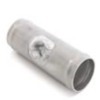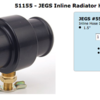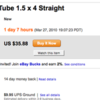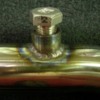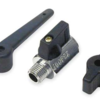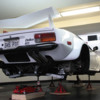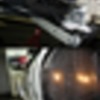I had a long list of winter projects that I delayed and delayed. A cold, dirty garage in winter is not the most appealing place to be. And working under a car (even the cat) is not always first choice vs sitting on the couch with a beer in hand. Yet, every day I walked past the cat, I promised I would get to work. Well, I'm sure you all know exactly what I'm talking about.
Anyhow, things are now moving along much faster since the weather warmed up. I threw the wife's dirty car into the driveway, washed out the garage and am hard at it.
Aside from the regular maintenance projects - and the added "might as wells" created by taking everything off the car before I could begin - I am finally deep into the four main projects I planned for this winter
Step 1 - inspect for rust, scrape and paint underbody
Step 2 - replace rad
Step 3 - update interior electronics
Step 4 - improve exterior lighting
Here's where I am so far:
Step 1 - UNDERBODY CHECKUP
Step 1 is progressing well. I got a lot of advice and suggestions on materials and processes. But still it is a nightmare of a job that I really should have left for another time. Like retirement. Or old age.
But after inspecting the underside carefully I am pleased that there was nothing serious to worry about anywhere. All was solid and not in need of any repair. But there was lots of surface rust appearing wherever the paint or undercoating had worn away. Of course getting to it was another story.
I discovered an odd array of internal splash shields and panels screwed on that I only found once I started removing the undercoating inside the fenders. Holy crap, I can't believe these parts were formed by Italian craftsmen. But I bought the car when it was less than 5 years old and doubt a previous owner did this work.
Anyhow, inside the rear facing sections of the front inner fenders, buried under lots of undercoating, were several handmade sheet metal panels all surrounded with rubber trim typical of the early 80s. This trim was on all the front facing splash shields when I bought the car. Anyhow, long story short, when all the screws and nuts were uncovered and removed I pulled them out to discover how well protected the car still is. Inside, the metal looked as if the car was completed a few years ago. Not 30 years ago. Clean, dry and still covered in a bright black undercoating and shiny wherever I removed these panels.
And so, knowing how well all was inside, I proceeded to spend the next week scraping and brushing anything that came off. Basically generating a huge mess. I should have left well enough alone. But now that I am done with the front half of the car I am feeling better about it, knowing I won't have to do this again. I really should have waited for when I was changing suspension bushings so I could have removed the entire suspension and had easier access to scrape and coat in a more complete way. But I'll redo some sections when that happens in a few more years. I am comforted by the lack of rust and how solid the channels were and how rust-free all suspension pickup points, ears and welds were.
The rad is out, the front tubes removed, the chassis was scraped clean, wires replaced, hoses replaced and all surface rust areas were treated with POR15 - recommended by many as the right stuff for the job.
And as promised, it turned out to be a permanent skin decoration. Mask, hazmat suit and gloves aside, spending any serious time painting a surface 2" above your face while lying on your back, is a recipe for drips and you're bound to rub against them as you roll around. As I said, I am glad that part is over. Pics to follow. Pics of the shiny black underbody, that is, not the shiny black body stains my wife enjoys commenting on "...honey, you missed a spot..." each morning as I get out of the shower.
Step 2 - RAD CHANGE
My Fluidyne lasted a little more than 3 years - suffering from multiple location corrosion and pinhole leaks. A lot of the rails and valance had been attacked by a year of drips here and there that ran along the underbody resulting in soft undercoating and surface rust wherever collected. I scraped and painted the complete inside rad area, front rail and valance with POR15.
After much review of alternate rads and custom choices, I decided to go with the Fluidyne. Again. I assumed the rad problem was due to the high silica content Prestone I was using. So I followed the advice on this board and ordered NoRosion's Hyperkool. They were a very pro outfit to deal with and also told me about electolysis being the leading cause of quick corrosion of aluminum rads - not the silica in the Prestone I was using. Once the system is back together I will take some volt readings in the coolant with engine on and off and report back.
I am repainting the fan brackets and mounts and redid their wiring along with all the rest of the wiring up front. I have 2 pusher fans and one sucker - 1 pusher on the rad sensor, and the other two on manual switches. Each now has a separate fuse and relay which will be mounted together in the front area.
I also added some brass fittings and pipe to plumb an extended rad drain so I can drain the rad without soaking the front rail anymore. That always killed me.
I'll post pics once it's all back together.
Step 3 - CONSOLE ELECTRICS
I have a Kenwood A/V and NAV system with Bluetooth. All required software and hardware updates. Nothing like watching your map go black as your NAV lady informs you "you have now gone off the end of the earth."
I had to download some NAV updates from Garmin. I also had to replace the Bluetooth unit so it would work with the latest generation iPhone. I really didn't need to know the recording date and album name on which ZZ Top recorded a particular tune from my iPod, but having my entire address book visible will sure made finding addresses and making voice calls easier on screen than fumbling for my phone.
Changing the memory cards and hardware required that I remove the console, under which it is all buried. I don't know about other cats, but I am so sick of dropping wires from switches as I remove them or move the console. There's never enough slack in the wire to any of these switches. So I'm finally doing what I should have done the first (and second)time around.
All the console switches are now wired into two fat connectors. So now I can just open the console glove box, pull out the tray, grab the two block conectors, unplug them and then lift the entire console out. This is the ultimate simple servicing solution for so many things that will eventually require my attention - shifter, linkage, heater hoses, carb cable, etc.
Oh, a freakin' necessity too, given that since I installed the new interior with 10 switches ALL MY WIRES ARE RED!! Try figuring that out on a GT5 using an early model wiring diagram! Thanks to Luc, our local Montreal Pantera electrical wizard for doing a fantastic job!
Here are some pics of the console / switch wiring. My next post covers the exterior lights.
Attachments
Original Post





